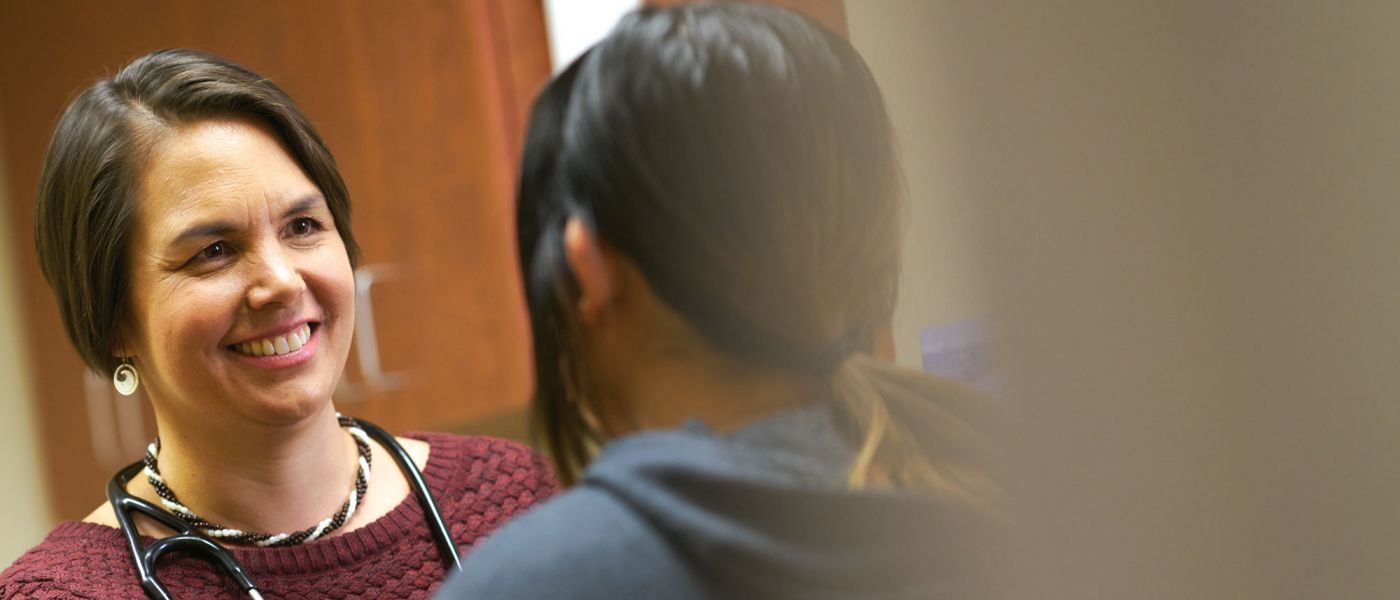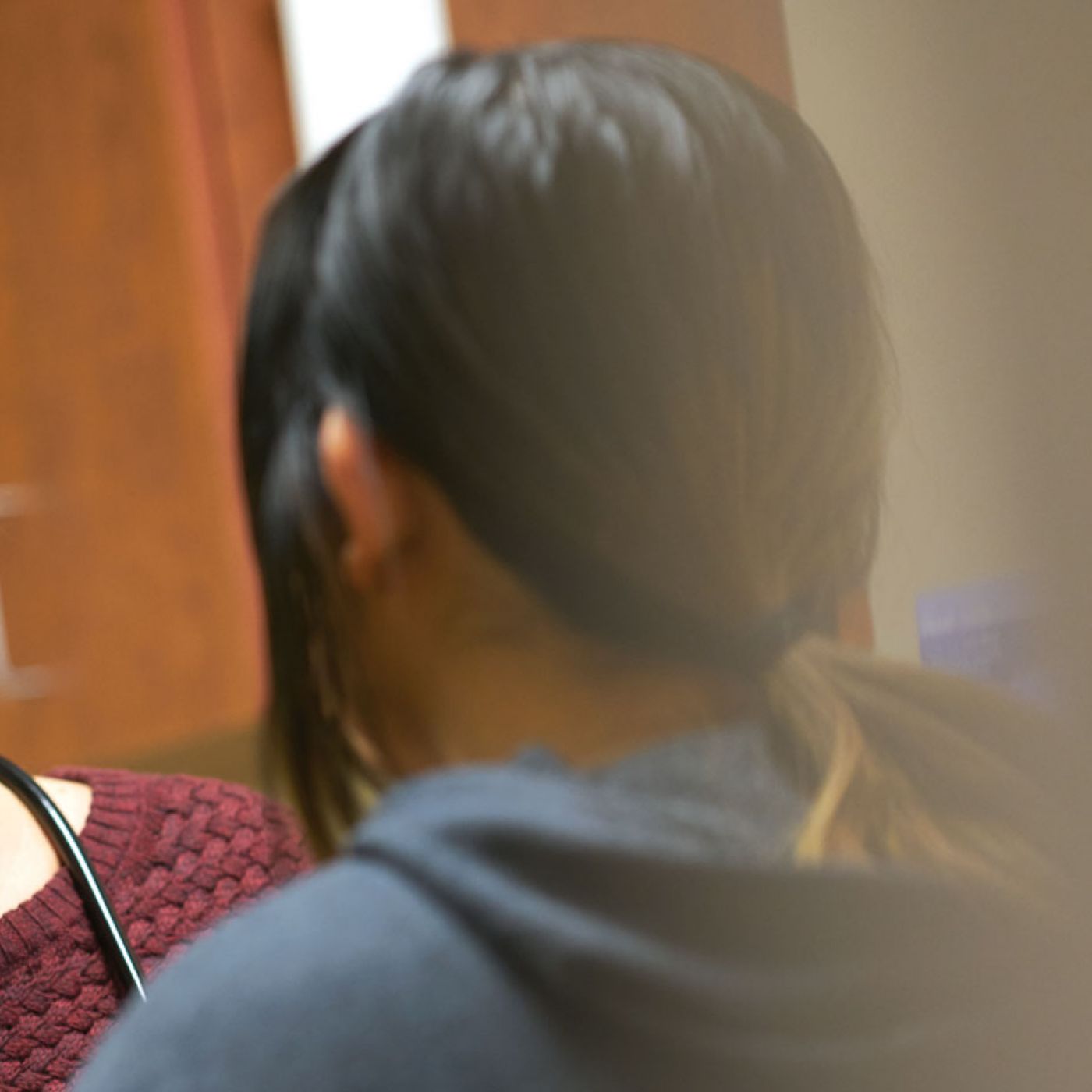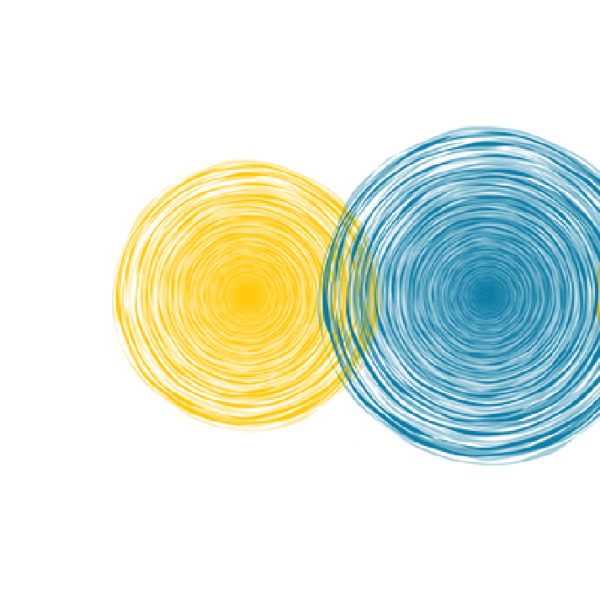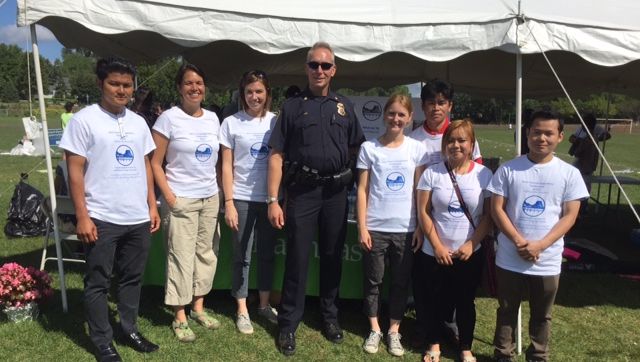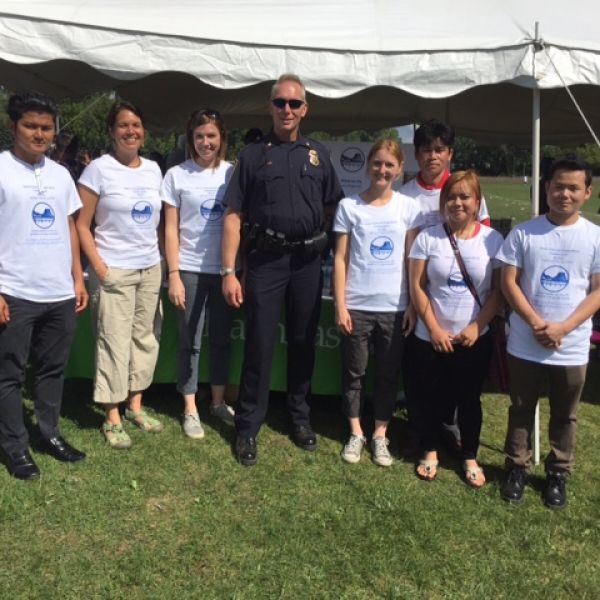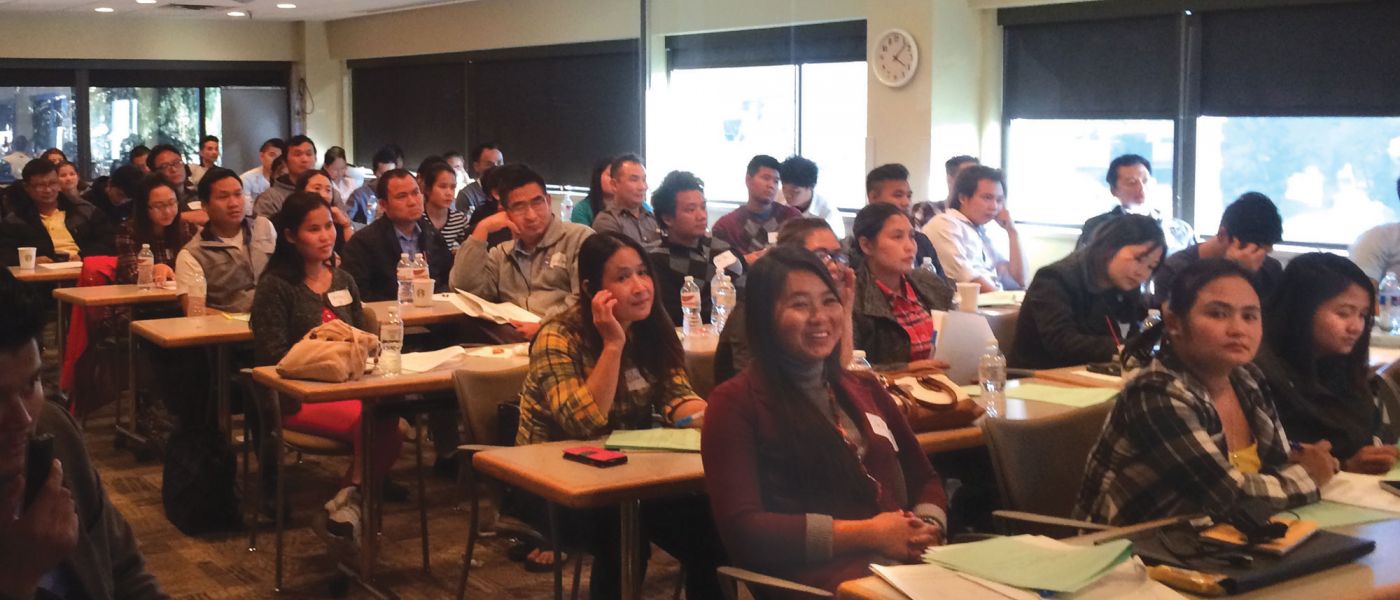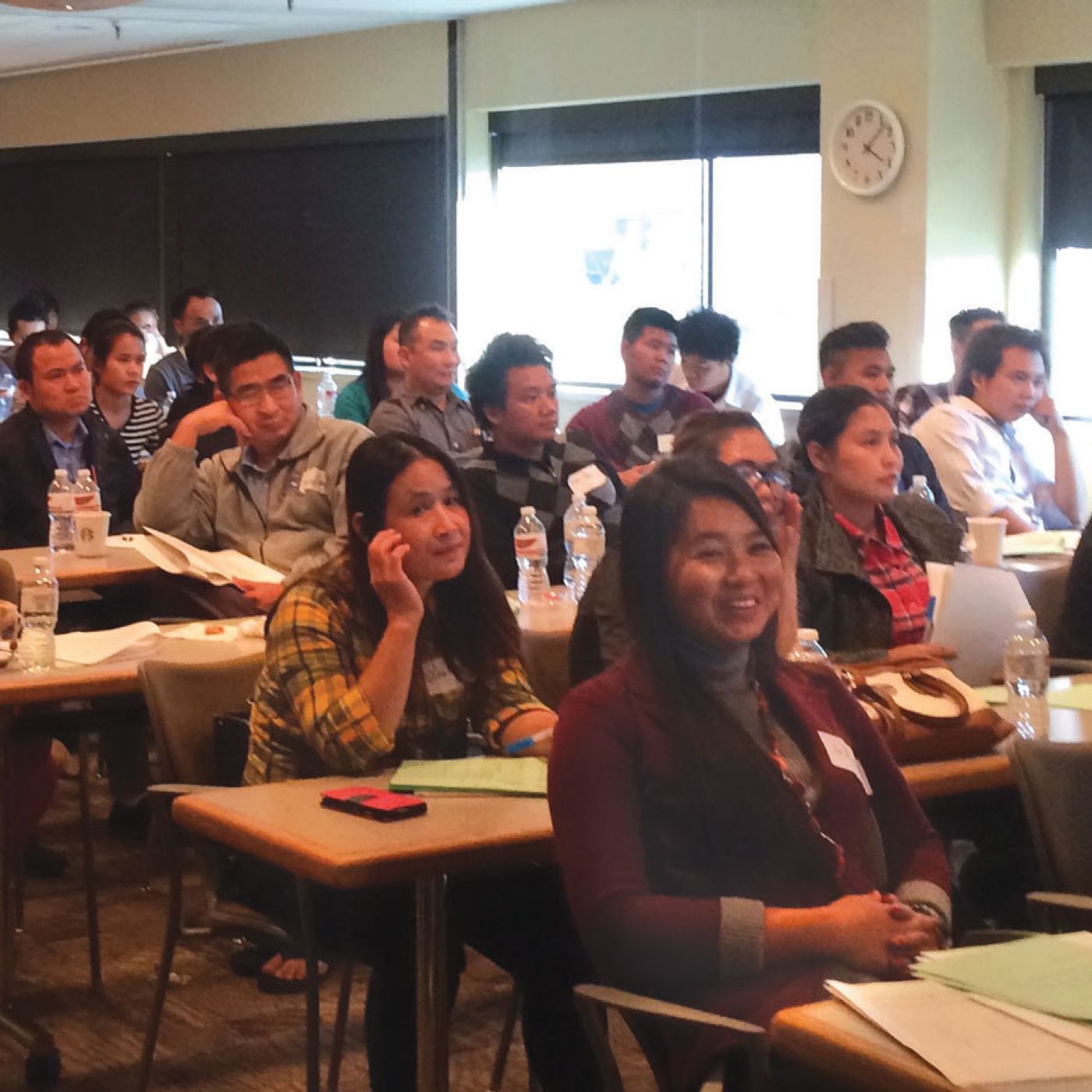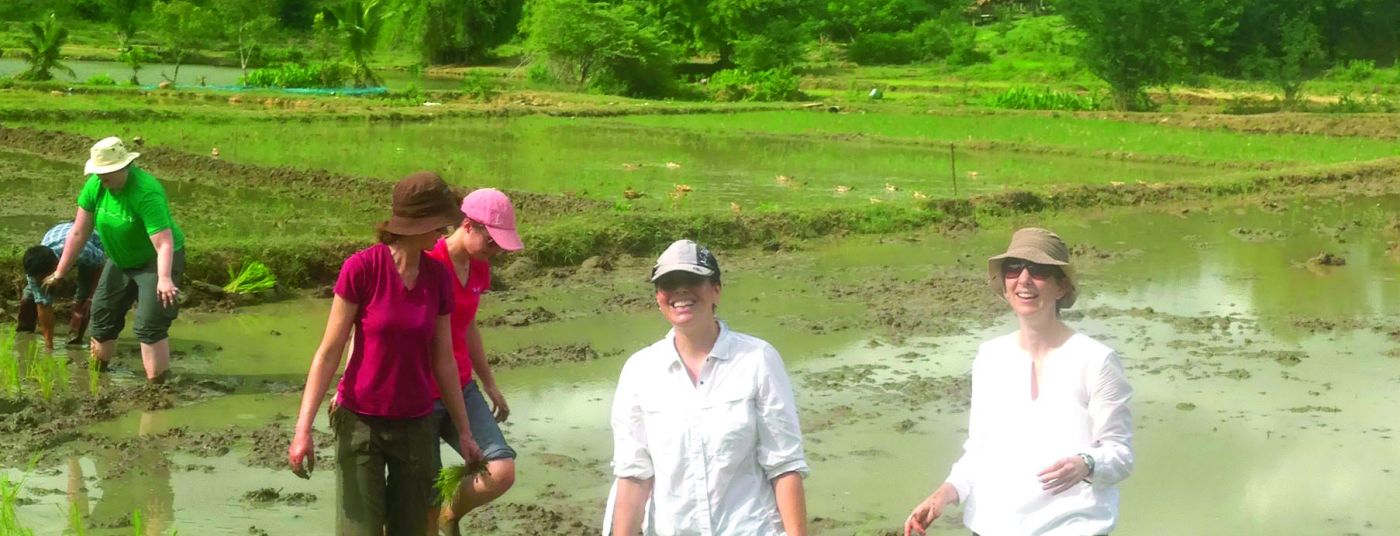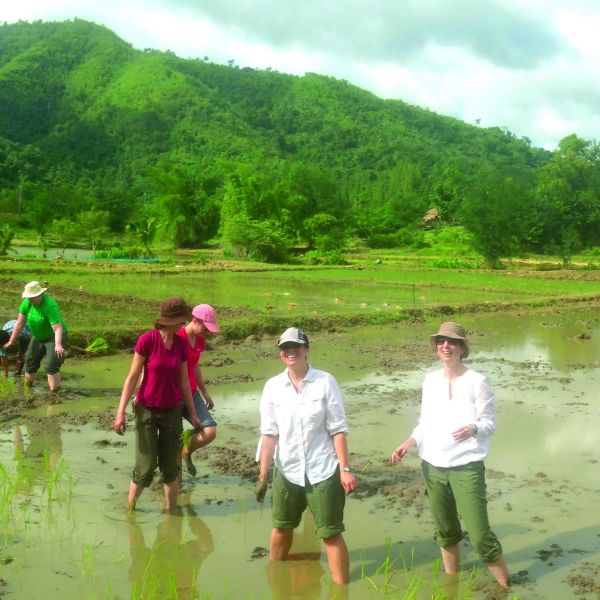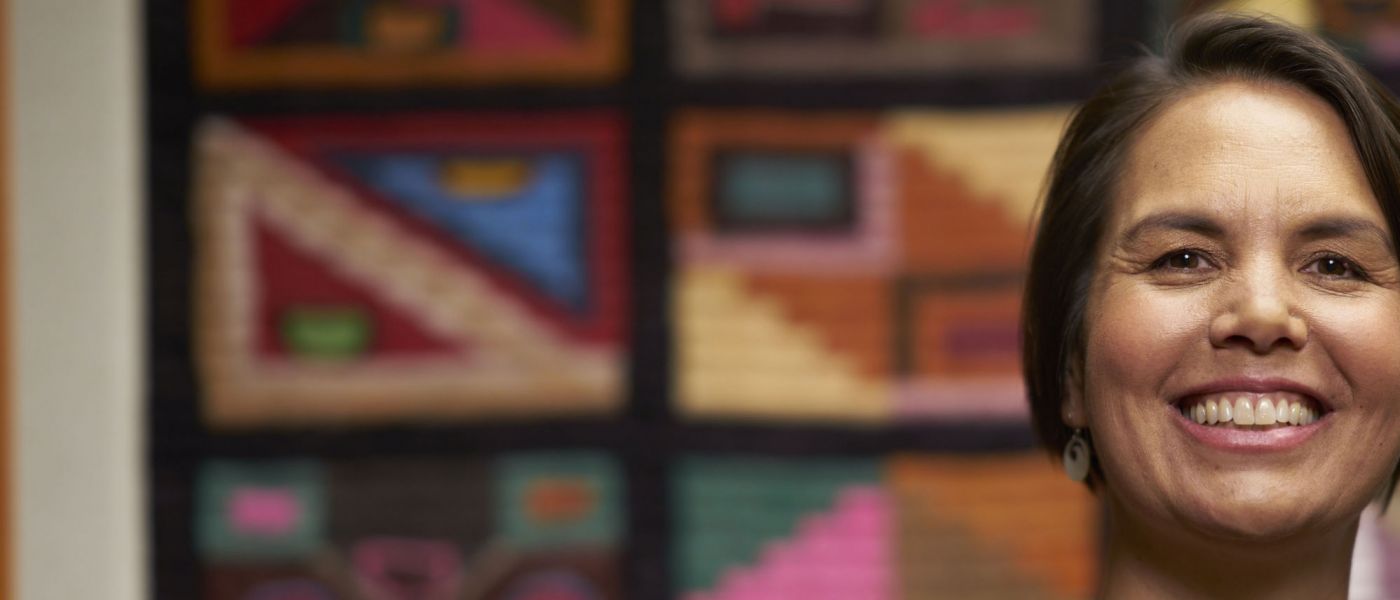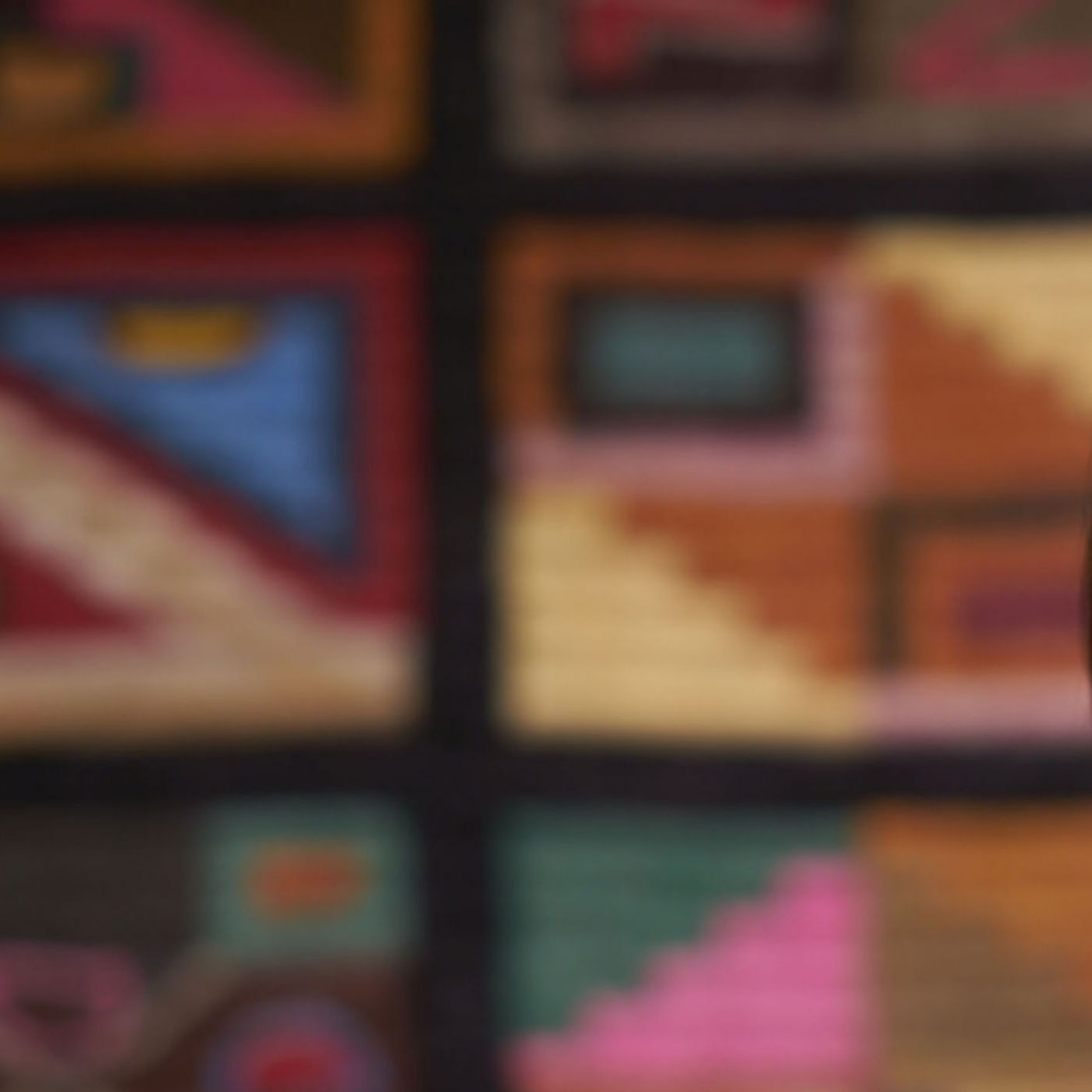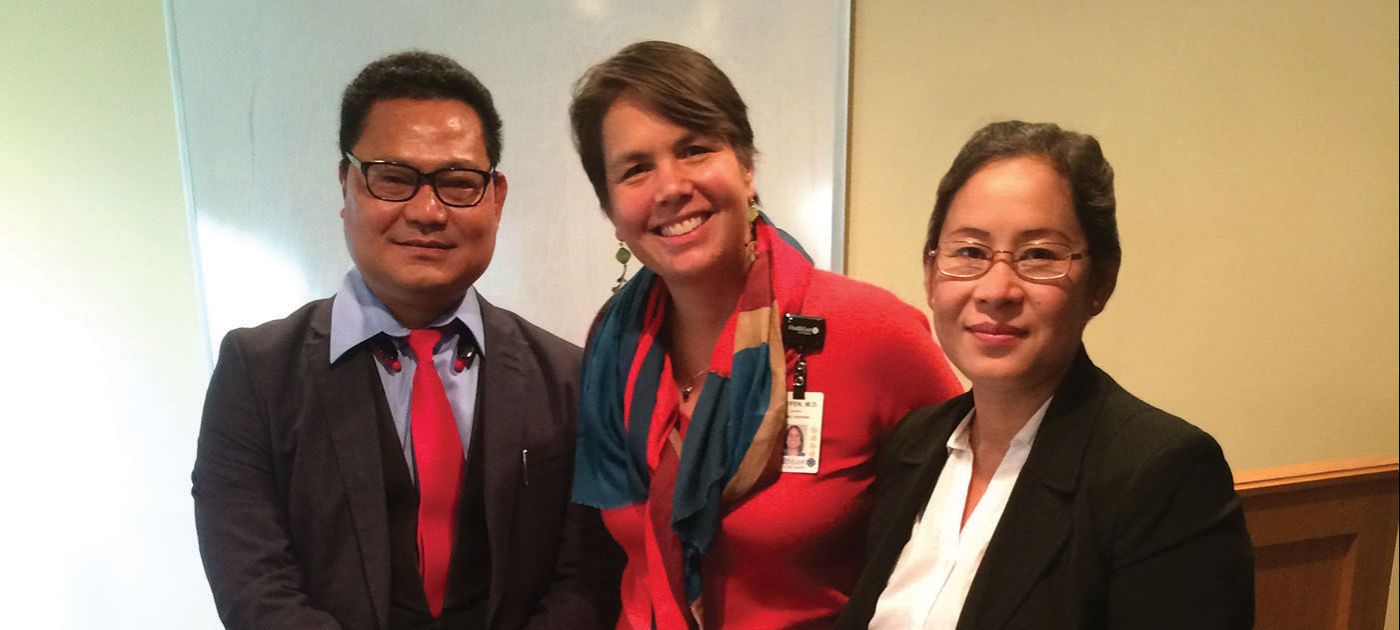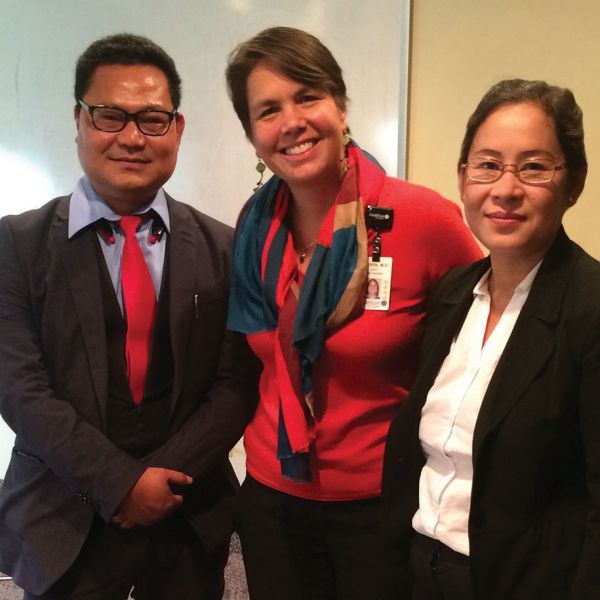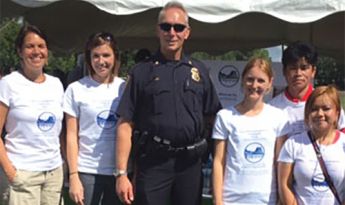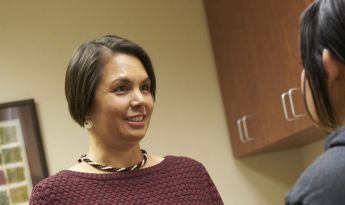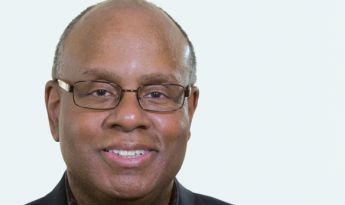Shana Sniffen, M.D., a 2013 Bush Fellow, glides through the corridors of HealthEast Clinic — Roselawn in Maplewood, Minn., the very picture of confidence and comfort, chatting easily with patients and staff, navigating multiple layers of complexity as if they weren’t even there.
To the casual observer she seems so relaxed and poised that it might never occur to anyone that inside, she works hard to release the nagging perfectionism with which she contends.
“A mantra I learned from my attending in the emergency room at medical school that I use daily is, ‘Your work does not need to be perfect, but it needs to be adequate, appropriate and to the best of your ability,’” says Sniffen.
Inherently honest and modest, Sniffen seldom speaks of herself as a leader or creator. She talks about being a “connector” and “cultural translator,” but even those words don’t flow easily from her mouth. She is very much aware that the work of crafting cross-cultural coalitions — the work she has spearheaded since 2013 with the Karen Organization of Minnesota (KOM) and its leadership — is nurtured by the milk of human kindness, leavened with a dash of humility and a pinch of indirect communication.
During a recent clinic visit with one of her patients, a woman who has just had surgery, Sniffen leans forward, gently pats her arm and asks, “Is there anything else you’d like to tell me?” The musicality of her voice and the light in her eyes draw the patient in and, as Sniffen listens, it is easy to see why her patients keep coming back: Sniffen gives herself over to her patients.
Indeed, Sniffen notes that one of her continual challenges is finding time to NERS (pronounced “nurse”) her soul through regular Nutrition, Exercise, Reflection and Sleep.
Taking care of herself isn’t something she squeezes in around the fringes of her life. In fact, it is vital to the work itself. Because, not only is Sniffen a highly sought-after family medicine physician at the Roselawn Clinic, she is also a co-founder and co-leader of the Karen Chemical Dependency Collaborative (KCDC), the first Karen-focused chemical dependency organization in the United States.
“...I will build the foundation for the Collaborative Community Network for Karen refugees…the goal will be to find ways to share resources, avoid duplication of services or working at cross purposes, and empower refugee families."
Excerpt from Dr. Sniffen’s 2013 Bush Fellowship application
In her original Bush Fellowship application, Sniffen declared, “…I will build the foundation for the Collaborative Community Network for Karen refugees…the goal will be to find ways to share resources, avoid duplication of services or working at cross purposes, and empower refugee families.”
A Vast Network
From her original vision has come a vast network of individuals from the Karen community, law enforcement, the state health department, immigration, social services, healthcare, translation services, education and the faith community that provides support for about 12,000 Karen refugees, most of whom live in St. Paul, Minn.
Many have found their way to Sniffen in her role as a primary care provider, advisor or collaborator who has worked tirelessly to support the largest population of Karen refugees outside of Burma, now called Myanmar, and Thailand.
There Are Different Ways of Knowing
The major focus of this larger network is now the KCDC project, which is designed to “center Karen voices” in the fight against chemical dependency within that community. Sniffen co-founded KCDC with Karen leaders, who identified culturally relevant treatment for harmful alcohol use as one of its most important needs.
The heart of this effort has been prodding Western medical and social service organizations to acknowledge there are different ways of knowing, and that the Karen community, despite its many needs, is in the best position to solve its problems.
Who are the Karen people?
There were once more than 135 ethnic groups inside Burma before it was colonized by the British and then the Burmese military took control in 1962. One of those ethnic groups is the Karen people, many of whom were Christianized by Protestant missionaries in the 19th century.
In Burma, the Karen work primarily in rural communities as subsistence farmers growing rice or as hunters of animals and insects to feed their families. They are expert botanists and use herbs and other natural substances as medicines. Karen villages are led by elected Headsmen; but within rural families, the work of running a household is divided equally between husband and wife. Households are multi-generational and often include grandparents as well as an average of three children per family.
The Karen ethnic minority fought on behalf of the British Army in Burma against the Japanese in World War II and, when Burma received its independence from Britain in 1948, the Karen people eagerly anticipated independence. Instead, they were abandoned by the British and eventually took up arms against the Burmese government in the Karen insurgency in 1949. Hundreds of thousands of people have been killed over the past 68 years in one of the longest running civil wars in modern history.
Today more than 140,000 Karen people live in deplorable conditions along the Thai-Burma border in camps administered by the United Nations High Commission for Refugees. Because some have been Christianized, they have garnered support from churches to make the long journey to the United States, Australia, Canada and England, among other nations
Once they arrive, the Karen confront extreme cultural differences between life in the Burmese villages, the Thai refugee camps and swarming urban centers like St. Paul. On top of these disorientations, many have spent years evading the Burmese military, walking hundreds of miles to camps, experiencing torture, rape, monsoons, the death of family members and other atrocities.
"[The Karen people are] independent, respectful and reserved. They seem simply to be people who want the opportunity to work, contribute, raise their kids and live their lives, not dissimilar to the vast majority of folks, regardless of ethnicity.""
Commander Dave Kvam
When they arrive in St. Paul, most Karen refugees are immediately in debt because they must repay the cost of their airline tickets. They are forced to work in factories or other low-wage occupations before they have time to acclimate to life in the United States. Due to post traumatic stress disorder from years on the run and confinement in the refugee camps, some turn to alcohol, drugs and domestic violence, which can lead to conflicts with law enforcement that re-traumatize them and break up families.
Commander Dave Kvam of the Maplewood Police Department said that the Karen people are, “independent, respectful and reserved. They seem simply to be people who want the opportunity to work, contribute, raise their kids and live their lives, not dissimilar to the vast majority of folks, regardless of ethnicity.”
But, like others who experience difficulty in life, some Karen refugees become chemically dependent. Ehtaw Dwee, KOM’s first board president, co-founder of the KCDC and a Karen language interpreter, says he believes that alcohol in particular is killing his community.
“When I travel around the country as an interpreter, I see many sad stories affecting my people, and if you were in my shoes, you would understand what I mean: domestic violence, cheating on people, DUIs, family breakdown. This has to stop. We as a people must be more honest with the community and with ourselves. We need to admit that we have a problem and then get proper treatment. That is the purpose of the KCDC, and we must succeed.”
“There are many examples of how the Karen people are self-organized, create structures, support systems and interventions for the problems in their community,” says Sniffen.
Connecting the Dots
While this trauma cycle is common among many groups, when Sniffen began public health screenings of new Karen refugees several years ago, she noticed that they exhibited an unusual combination of resilience, strength, humor and appreciation. She also realized that traditional Western social and medical systems are highly fragmented and that unless someone “connected the dots,” with Karen voices leading the way, any effort to address alcohol and drug abuse would be doomed before it began.
“There are many examples of how the Karen people are self-organized, create structures, support systems and interventions for the problems in their community,” says Sniffen. “It’s just that mainstream providers do not often know about these grassroots efforts or that they look different. So, one of the strategies of KCDC is to try to uncover what these are and offer ways to be supportive and share resources.”
Ehtahler Dee, a Karen refugee who works with KCDC, explains that when he first became involved in the project: “I saw that there was something about the traditional American treatment that is not right for the Karen people. I met with Dr. Sniffen who was talking to people about how to create a better approach, and I became the cultural liaison for KCDC and assisted in creating a curriculum specifically for the Karen community.”
“What I like about KCDC is that it feels like home, working here on a team with Americans who want to share with us,” Dee explains. “They let the community drive the approach, and I feel very comfortable working with American providers. Even though they have a higher education than us, they still make you feel like we can work together.”
In accord with this idea of sharing expertise across cultures and systems, Sniffen strives to create comprehensive programs with the Karen community, not for them. Her open, warm approach makes all the difference in the world.
“I think the fact that we have a successful community collaboration that’s bringing resources together is really helpful,” Sniffen said. “We are mobilizing treatment that is specific to a refugee community and takes into account the language, the culture and the trauma. There’s a whole group of patients that is not being served, and we’re right on the cusp of making that happen.”
She uses the term “on the cusp” for several reasons. First, the collaboration she is building is not yet complete. More must be done to break down cultural barriers, transform the various systems involved and provide appropriate treatment options for the Karen community. Also, KCDC, the centerpiece of Sniffen’s work, is in the midst of completing a second field test of its principles and concepts. No comprehensive study of its work has yet been attempted or published.
Finally, in ways that mirror the Karen people themselves, Shana Sniffen is reticent to talk about herself. She does not want to be the center of attention. Yet, it is impossible to understand the intricate nature of the work she is doing without knowing her personal story.
Beautiful Inside & Out
“Shana” is a Yiddish name meaning “beautiful.” Although she is not Jewish, nearly a quarter of a century ago Sniffen met a rabbi who told her that “Shana” has deep meaning and that a person needs to be beautiful inside and out to live up to his or her full depth.
The rabbi’s observation intimidated her. “I felt a little pressure at 23 years old that I might not be able to live up to its meaning, given I don’t have a lot of control over the outside,” she said. “But I can try my best for the inside beauty at least.”
The surname Sniffen comes from the Anglo-American part of her family. A Sniffen ancestor from New York sailed to Hawaii in the 1800s, married a Hawaiian woman and had 10 children. One of those children was Sniffen’s great-grandfather, who married a Hawaiian woman and had 17 children, including Sniffen’s grandfather. In turn, he married a Chinese woman who gave birth to four children, including Sniffen’s dad, who married a white woman.
Sniffen is therefore a product of interracial marriages dating back several generations and says that perhaps this background contributes to her perspective on what she calls “cultural bridging.”
“I grew up learning from my grandparents the importance of family connections, cultural pride, internal strength and taking care of others,” she said. “My Chinese grandmother instilled in me a sense of adventure, curiosity about people and the importance of being able to laugh at myself.”
At California State University in Fresno, where she majored in Speech Communications and Rhetoric, Sniffen received a grant to develop a cross-cultural student network to ease the tensions from racial violence on campus. Because her family wasn’t wealthy, she took various jobs in social services — with organizations that addressed homelessness, domestic violence and mental health issues — for nine years before attending medical school.
She had already decided that one day, she would work with underserved communities.
At the University of Washington Medical School, Sniffen completed a certificate in Native American Health and worked in Zambia for six months on a collaborative research project on HIV/AIDS. She then moved to Minneapolis specifically to work with Hmong and African American patients.
In 2013, while facilitating the Karen Patient Advisory Committee for the Roselawn Clinic, Sniffen applied for a Bush Fellowship. She chose to assess the needs of the Karen community, learn about gaps and barriers in service and explore ways that other communities built resources needed to assist refugees in transition.
Even from the beginning, Sniffen was thinking far beyond medical care and looking at a more comprehensive, culturally relevant safety net that would serve the Karen people. Her initial application included a vision of “creating a public website with a list of stakeholders and downloadable culturally competent and language appropriate resources.” (Recently, she achieved this goal by launching a website known as “Toh Moo” pronounced “dtoh moo,” which means “bridging life.”)
Just before Sniffen applied for a Bush Fellowship, a treasured 20-year relationship came to an abrupt end and propelled her toward a personal and professional transformation. She wrote in her Fellowship application, “I still feel powerless at times being a single provider working one-on-one with families, when many of their struggles are due to larger social and systemic problems.”
In other words, Sniffen longed to go beyond the personal intimacies she shared with Karen patients in her clinic to create a broader healing network where simply inviting Karen refugees to participate would constitute a therapeutic intervention.
"I still feel powerless at times."
From Sniffen's Fellowship Application
Three years later, while she may feel somewhat powerless in her battles to make multiple systems more responsive to refugee needs, Sniffen understands that she wields great power for her patients and within the Karen community.
The genius of her approach is that she uses her power by deflecting it — deploying it to unite disparate peoples around a common goal, affirming that different ways of knowing are useful because they are different, and that all ways of knowing are welcome in her world.
The Karen Chemical Dependency Collaborative
With the help of the Bush Foundation, HealthEast Foundation, Medica Foundation, F. R. Bigelow Foundation and the St. Paul Foundation, Sniffen brought an incredibly diverse group of people together to examine the impact of not just medical or chemical dependency treatment methods but also the impact of the social determinants of health on the Karen community.
The sheer number of participants in the collaboration is mind boggling. Sniffen tries to ensure that at least 50 percent of the people in attendance at meetings are Karen, even going so far as to ask mainstream agency managers to bring their Karen staff or offering gift cards to pay some interpreters to attend meetings to avoid lost wages as a barrier to participation. She believes that Karen voices must be heard and that solutions need to arise organically from an interplay between Karen people and the mainstream community.

"We have managed to create a team of people across multiple professional, cultural and linguistic backgrounds that functions as a resilient and flexible organism in the face of overwhelming uncertainty and upheaval."
Jennifer McCleary, professor at Tulane University and a member of the KCDC
The genesis of KCDC
Jennifer McCleary, a professor at Tulane University and a member of the KCDC who is designing a new, culturally relevant alcohol abuse curriculum, couldn’t agree more.
“We have managed to create a team of people across multiple professional, cultural and linguistic backgrounds that functions as a resilient and flexible organism in the face of overwhelming uncertainty and upheaval. We have created a collaborative that is actively responding to harmful alcohol use in the Karen community. That is, I believe, the most important core of what we are doing.”
McCleary has worked with several Karen partners to create this new curriculum. Current treatment programs lack quality interpretation, are not culturally relevant and are difficult to navigate because of barriers like insurance, transportation and health literacy.
“This is the genesis of the KCDC,” McCleary explains. “We believe that programs need to be adapted systemwide to ensure that Karen people have access to needed treatment. One way we are responding to this need is through developing an outpatient group treatment program that is entirely organic to the Karen community.” The program is co-facilitated at the Roselawn Clinic by an American-born licensed clinical social worker and a Karen leader who has also been trained in the refugee camps in Thailand to provide chemical health treatment.
One improvement outcome of the treatment redesign involves transforming the initial diagnostic assessment. Western diagnostic assessments are typically long and multi-layered with questions that are irrelevant or confusing for Karen people.
“Actually, the entire (Western) process is incongruent with information gathering in the Karen community,” McCleary contends. “One reason Karen people struggle with entering into treatment is difficulty getting through the diagnostic assessment. With guidance from Karen community members, we have adapted the diagnostic assessment questions to be more culturally relevant and to use language that is more easily translatable. We have also cut the assessment into multiple pieces, and it is partially done by a Karen person, in Karen, in the patient’s home.”
The Six C's
Of greater importance than the actual programming has been KCDC’s approach and process, according to Sniffen. For example, the group’s guiding principles are known as “The Six C’s:” Collaborative, Community Driven, Culturally Responsive, Comprehensive, Capacity Building and Compassionate.
- Collaborative
- Community Driven
- Culturally Responsive
- Comprehensive
- Capacity Building
- Compassionate
Other principles include valuing and prioritizing cultural indigenous strengths as equal to American concepts, and encouraging mainstream organizations to be more culturally adaptive, responsive and humble.
“In some ways, this is the essence for breaking down disparities,” says Sniffen.
Many Trained Voices
Ehtaw Dwee also notes the importance of having many trained voices in the fight against alcohol and drug dependency.
“People may not listen to the doctor, but they listen to their pastor, so we train the pastor. Can you imagine how hard that is?” he asks. “The pastor is the person who tells you what to do. But we tell the pastor what to do.”
“We also want the probation departments to do a better job because my people who are convicted don’t understand what happens when they are arrested,” he continues. “They think, ‘Oh, I have been punished already, I am done.’ But they have to follow up with rehabilitation. The probation officers need to let them know that the judge is not angry, he wants you to follow up.”
"I have taken as a personal motto the idea of seeing needs, which I learned from the Karen people."
Tonya Cook, program manager and program developer for KCDC
Seeing Needs, Valuing People
In the end, Sniffen’s vision with KCDC is about creating a cross-cultural learning network.
“I would never have known when I started this project that training the interpreters or creating a Karen language glossary for mental health and addiction terms to have shared vocabulary for concepts and words that do not exist in the Karen language was necessary — without listening to the Karen leaders and interpreters,” she says.
Tonya Cook, a social work Ph.D. candidate at the University of Minnesota, is the program manager and program developer for KCDC as well as a founding member of KOM. She met the first wave of Karen refugees in St. Paul in 2004 and has since developed deep friendships with members of the community. She says that among the many things she learned from the Karen people is to look at life through the lens of community as opposed to an individualistic perspective.
“I have taken as a personal motto the idea of seeing needs, which I learned from the Karen people,” Cook says. “When people’s basic human needs are not being met because of poverty, you don’t have to wait for them to ask — you can see they need food, you can see they need a job, you can see they need warm winter gloves. If you have something, just give it.”
Different Meanings of “Help”
She has also learned from the Karen that it is more important to value people over money or possessions and that the word “help” means different things to Karen people than to those in the dominant U.S. culture.
“As one Karen woman astutely pointed out, in dominant U.S. culture, ‘help’ means ‘I will help you to help yourself.’ In Karen culture, ‘help’ means ‘I will throw myself in front of you.’ As I understand it, she was saying something like she would stand in front of a bullet for you. She would sacrifice herself for you,” explains Cook. “Indeed, I see that type of sacrifice displayed by Karen people every day. When a family is new to the United States and they don’t have enough for rent this month, they tell a friend and they get ‘help.’”
Sniffen’s greatest achievement may be that she has fully embraced the very difficult work of moving past linguistic and cultural differences by respecting and valuing those differences. She has navigated the stages of leadership from individual practitioner to event planner and finally to “bridge and guide.”
As she continues this journey with her many professional partners, Sniffen says that the term “leader” feels too self-important “given how mutually collaborative this work is.”
In reflecting on what she has accomplished and how much more there is to do, Sniffen wrote the following note:
“I came up with this statement today as a summary of my philosophy: While I try to accept things that I cannot change, I also try to change the things that I cannot accept.”
"The good physician treats the disease; the great physician treats the patient who has the disease."
William Osler
Over a century ago, the physician William Osler noted that, “The good physician treats the disease; the great physician treats the patient who has the disease.”
In this case, Sniffen is engaged in the deepest kind of co-production of healthcare services, involving patients in their own diagnosis, treatment and follow up. To some extent, the work she is doing to reform healthcare systems envisions the system itself as part of the disease process. That system will never be healed unless all stakeholders are fully engaged and respected. She is showing us how to do just that.
By Osler’s definition or any other, Dr. Shana Sniffen is indeed a good and a great physician.


